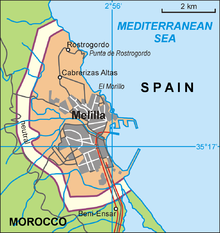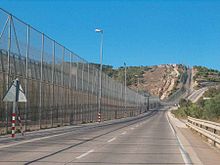Melilla border fence



The Melilla border fence forms part of the Morocco–Spain border in the city of Melilla, one of two Spanish cities in north Africa. Constructed by Spain, its stated purpose is to stop illegal immigration and smuggling. Melilla's border and its equivalent in Ceuta, also bordering Morocco, are the only two land borders between the European Union and an African country.[1]
Recent history
[edit]In September 2005, some thousands of sub-Saharan African migrants tried to climb over the fences in several waves moving upon Melilla. About 700 made it past the fences while six died in clashes with Moroccan security forces.[2] The 2005 events at the Melilla and Ceuta border fences are the subject of a documentary film, Victimes de nos richesses.[3]
Three hundred people attempted and 30 succeeded in climbing the fence in August 2020, some of the 2,250 people who entered Ceuta and Melilla in 2020. Eighty-seven people scaled the fence on 19 January 2021; nine were taken to hospital.[4] 2000 people attempted to scale the fence on 24 June 2022; 133 successfully. Twenty-three people died and several were taken to the hospital.[5]
Renovation
[edit]Anti-immigration sentiment toward African migrants prompted the Spanish government of José Luis Rodríguez Zapatero in 2005 to build up a new border fence. This border fence, built next to the two deteriorated existing ones, completely seals the border. In 2018, the new interior minister of Spain recognized the anti-immigration sentiment that the fence stems from and vowed to replace the razor wire along its top with more humane deterrents. "Spain's new interior minister has vowed to do "everything possible" to remove the "anti-migrant" razor wire fences, which separate Morocco from the Spanish territories of Ceuta and Melilla."[6]

This third razor wire barrier cost Spain €33 million to construct. It consists of 11 km (6.8 mi) of parallel 3 m (9 ft 10 in) high fences topped with barbed wire, with regular watchposts and a road running between them to accommodate either police patrols or ambulance service in case of need. Underground cables connect spotlights, noise and movement sensors, and video cameras to a central control booth. In 2005 its height was doubled to 6 m (19 ft 8 in) since immigrants were climbing the previous fences equipped with home-made steps. Also, devices to slow them harmlessly were added to facilitate the intruders' detention.[citation needed]
Even with three fences built, people still scale them and arrive on Spanish territory.[7] From these, Amnesty International and Médecins Sans Frontières accused the Moroccan government of dumping people from various African countries (some of them claiming to be validly registered as political refugees) in an uninhabited area of the Sahara Desert without food or water supplies.[8]
See also
[edit]References
[edit]- ^ Bilefsky, Dan (20 February 2017). "More Migrants Storm Fence to Enter Ceuta, Spanish Enclave in Africa". The New York Times. ISSN 0362-4331. Retrieved 12 May 2017.
- ^ Woolls, Daniel; Emmanuel Tumanjong; Todd Pitman. "Far from home, African immigrants tell families about grueling ordeals to reach Europe". Union-Tribune Publishing Co. Associated Press. Retrieved 6 January 2008.
- ^ Barlet, Olivier. "Victimes de nos richesses". Africultures (in French). Archived from the original on 1 January 2013. Retrieved 16 March 2012.
- ^ "Migrants scale border fences to enter Spanish enclave". ABC News. AP. 19 January 2021. Retrieved 20 January 2021.
- ^ "Melilla migrant deaths spark anger in Spain". BBC News. 27 June 2022.
- ^ "Ceuta and Melilla: Spain wants rid of anti-migrant razor wire". BBC News. 14 June 2018.
- ^ "How a border wall works in Melilla, Spain, a gateway between Europe and Africa 2019". YouTube.
- ^ "Amnesty International- Morocco/Western Sahara: Amnesty International concerned". AMNESTY JAPAN.
External links
[edit]- (in Spanish) 2008-Oct-27: 50 persons enter Melilla after storm breaks the Fence
- "The razor wire that separates Europe from Africa might be coming down".
- "'Big, beautiful' walls don't stop migrants in the US and Europe".
- "Ceuta and Melilla: Spain wants rid of anti-migrant razor wire". BBC News. 14 June 2018.
- "How a border wall works in Melilla, Spain, a gateway between Europe and Africa 2019". YouTube.
- Attacking The New Border Wars
- Melilla border fence photo gallery: 1 2 6 7 8 9 10 11 12

